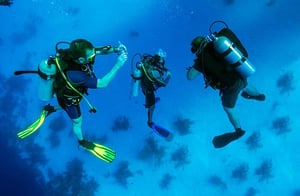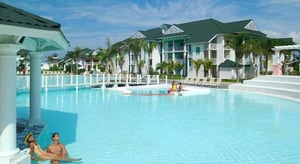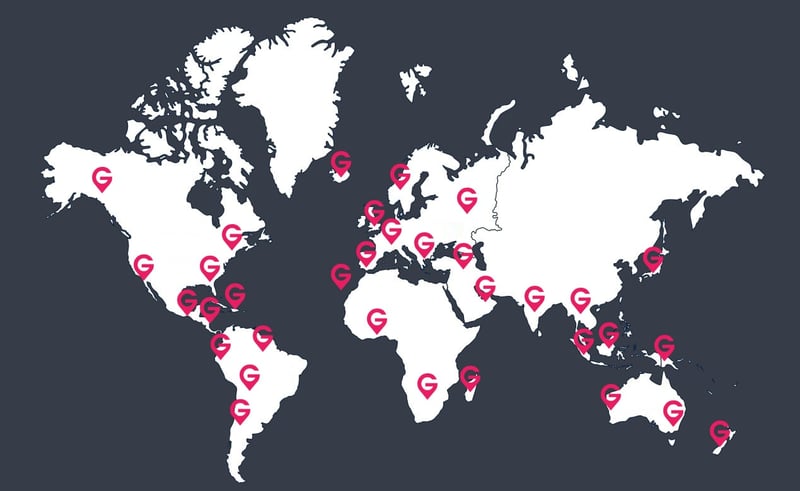Local Recommendations
Explore the World like locals
My Guide to Cuba
Local News & Articles
-

Quarantine Fitness Exercises
Family Fun Lifestyle SportsStaying home to beat the coronavirus is not synonymous with sedentariness. Keeping fit even when locked up is very simple. It only takes "20 minutes a day, 3 days a week to get it done. So says Samuel Torres, personal trainer and director of T-Center, CuídatePlus.
-

How do Cubans Celebrate the Valentine's Day?
Arts & Culture Celebrities Inspiration Retreats & RelaxationThe bride and groom, according to their economic possibilities, give each other cards or any other kind of entertainment to celebrate and celebrate that day. They also do it and exchange messages, friendships and friends. Many even give an engagement ring to their partner.
-

XXII Habanos Festival
Arts & Culture Celebrities Inspiration Mini Break Opening Party Press ReleasesHavana, the Cuban capital, considered wonder city and that is celebrating its 500th Anniversary, is getting ready to host once again the XXII Habanos Festival. The biggest international event for lovers of the world’s best tobacco, the Habano, will be held from 24 al 28 de February 2020. Enthusiasts of this unique product from all corners of the world will participate in a Festival that will see the San Cristóbal de La Habana, Hoyo de Monterrey and Trinidad brands taking centre stage.
-

Architectural route in the city of portals
Editorial Hot List Lifestyle Top 10A very attractive route to get to know Havana is through its most emblematic neighborhoods. For architecture lovers, that route can also be very interesting. The neighborhoods show the mixture of styles and influences that make up Cuban architecture and culture, where Spanish, Arabic, Italian, Greco-Roman, French or North American come together. They contain within themselves picturesque and striking elements, an attractive architecture and various activities for the enjoyment of locals and visitors.
-

Christmas in Cuba: celebrate a party that was banned
Celebrities Family Fun Inspiration Lifestyle Opening Party Press Releases Seasonal CelebrationsWe may think that Christmas holidays are currently unrelated to the religious holiday, however, we would be wrong. Elements such as stars, found in many decorations, angels or shepherds are closely related to the birth of the child Jesus. Therefore, it is normal that in many non-Christian countries the Christmas party is not celebrated, since for them on December 25 does not mean a relevant celebration in their calendars. However, there are also some countries which had celebrated the Christmas holiday, perhaps due to the colonization and immersion of religious beliefs in this area, but that over the years has been losing tradition.
-

Melia Cuba: on the reopening of its hotels.
Arts & Culture Family Fun Food & Drink Lifestyle Retreats & RelaxationGabriel Escarrer, executive vice-president and managing director of Meliá Hotels International, has pronounced on the return of the famous Spanish chain to reopen to tourism.
-

Christmas in Cuba? Havana smells of roasted piglet and salsa can be heard from homes
Arts & Culture Family Fun Food & Drink Hot List Seasonal CelebrationsCuban Christmas Eve is a great fiesta in the rhythm of reggaeton and salsa instead of Christmas carols. The snow does not creak underfoot, no one is queuing for a carp or Christmas tree, and the smell of roasting pig hovers in the afternoon heat throughout Havana. Holidays and New Year's Eve in Cuba look completely different than ours. And yet you can find many similarities. It is primarily a family, warm atmosphere and joyful fun until dawn on New Year.
-

Destinations for Hiking in Cuba
Adventure Family Fun Hot List Lifestyle Retreats & RelaxationTrekking in Pinar del Río: The province of Pinar del Río is perfect for hiking and trekking since here the original flora and fauna of the island is well preserved. Together with Varadero and Trinidad, Pinar del Río is one of the most visited destinations in the country. It is full of interesting sites: it has the largest underground cave system in Latin America, the Soroa Botanical Garden with its spectacular Orchid Garden and the "Valle de Viñales" declared World Heritage by UNESCO, a peculiar valley of the island because of its mountainous formations, (mogotes). Everything is perfect for the enjoyment of an excellent vacation practicing the Hiking (Trekking).
-

Cuba closes the country to tourism
EditorialThe Cuban government has made a drastic turn in its policy of confronting the coronavirus, which until now had not contemplated restrictions on the entry of tourists, and has announced that as of Tuesday only residents of the country will be able to travel to the island, and these will have to undergo a preventive quarantine of 15 days at an assistance center upon their arrival, whether they have symptoms or not.
What's On in Cuba
-
FEATURED

Mon 1st Dec Manuel Antonio National Park Combo Tour from San Jose
Mon 1st Dec, 2025 Cuba CubaExplore the Manuel Antonio National Park and its white-sand beaches on this day trip from San Jose. Enjoy the included breakfast and lunch, and stop to look for crocodiles and scarlet macaws.
-
FEATURED

Mon 1st Dec From Puerto Plata Priv: Cocoa, Coffee, Cigars & Local Market
Mon 1st Dec, 2025 Cuba CubaExplore the Dominican Republic's interior and discover the authentic Caribbean. See local cocoa groves and chocolate manufacturing, and enjoy coffee in a country house, markets, and a cigar factory.
-
FEATURED

Sun 30th Nov From San Juan: Bioluminescent Bay Kayak Adventure at Night
Sun 30th Nov, 2025 Cuba CubaExplore an amazing bioluminescent bay in San Juan on a fascinating kayak tour. Watch the glowing plankton of the Laguna Grande at night and learn about the local ecosystem as you paddle along.
-
FEATURED

Sun 30th Nov Cabo San Lucas: Beach & Desert ATV Tour with Tequila Tasting
Sun 30th Nov, 2025 Cuba CubaRide your own ATV through desert trails and oceanfront cliffs in Cabo. End the adventure with a tequila tasting and epic views you’ll never forget.
-
FEATURED

Mon 1st Dec Fuerteventura: Glass Bottom Boat Cruise with Lunch & Drinks
Mon 1st Dec, 2025 Cuba CubaSail through the Janía Natural Park on a cruise aboard a glass-bottom boat. Spot dolphins and whales and peer below the water through the underwater viewing deck.
-
FEATURED

Sun 30th Nov San Ignacio: Crystal Cave & Blue Hole National Park + Lunch
Sun 30th Nov, 2025 Cuba CubaGo on an adventurous jungle hike followed by an expedition into the Crystal Cave, a vast limestone cave system filled with intricate rock formations and huge caverns.
-
FEATURED

Sun 30th Nov Chiapas: Palenque Archaeological Site Skip-the-Line Ticket
Sun 30th Nov, 2025 Cuba CubaSkip the line and explore one of the most influential Mayan cities hidden in the heart of the jungle with an entry ticket to Palenque archaeological site. Admire the ancient structures and wildlife.
-
FEATURED

Mon 1st Dec Cayo Arena: Paradise Island and Mangroves Tour
Mon 1st Dec, 2025 Cuba CubaVisit one of the most beautiful islands on the north coast of the Dominican Republic and laze on the white sands of Cayo Arena. Swim and snorkel with the colorful sea life in crystal clear waters, and take a speedboat tour of Monte Cristi National Park.
-
FEATURED

Sun 30th Nov From Tucumán: Tafí del Valle, Quilmes Ruins and Cafayate
Sun 30th Nov, 2025 Cuba CubaVisit three unique places on this full-day tour from Tucumán. Explore the charming small town of Tafí del Valle, discover the Quilmes Ruins archaeological site in the Calchaquí Valley, and stop in the town of Cafayate, well-known for its wines.
Book Experiences in Cuba
-
FEATURED

World Of Controls
World of Controls is a leading company that specializes in providing innovative and comprehensive solutions in the field of industrial automation and control systems. With a commitment to excellence and cutting-edge technology, World of Controls caters to the diverse needs of industries such as manufacturing, process control, energy, and more.
-
FEATURED

7 Days Jewish Heritage tours from Casablanca
Explore Morocco's Jewish heritage in Casablanca, Fez, Rabat and Marrakesh, visiting synagogues and historic Mellahs. Enjoy stunning landmarks and a blend of cultures on this 7-day Jewish Heritage Tour
Check availability$2,377.51From -
FEATURED

Private City Highlights Shore Excursion & Guided Tour
Discover Puerto Plata's vibrant life on a guided city tour. Visit a rum distillery, explore Independence Park, and admire the oceanfront Malecón.
Check availability$1,200.00From
-

Things to do in Havana
Handpicked by a Local Expert
-

Things to do and best tours in Cuba
Handpicked by a Local Expert
-

Best experience and tours in Cuba
Handpicked by a Local Expert
-

Best city tours in Havana
Handpicked by a Local Expert
-

Best and most reliable airport transfers in Cuba
Handpicked by a Local Expert
-

Best tours in and around Varadero, Cuba
Handpicked by a Local Expert
-


10 Best Tourist Places in Cuba
Handpicked by a Local Expert
-


Valentine's Day in Cuba
Handpicked by a Local Expert
-


Best water activities in Cuba
Handpicked by a Local Expert
-


Things to do in Cuba
Handpicked by a Local Expert
-


Icon places to see in Cuba
Handpicked by a Local Expert
-


World Heritage Sites in Havana
Handpicked by a Local Expert
-


Holidays Tips for your January Trip to Cuba
Handpicked by a Local Expert
-


National Parks in Cuba
Handpicked by a Local Expert
-


Outdoor Activities you can enjoy in Cuba
Handpicked by a Local Expert
-


Best Cocktails in Havana, Cuba
Handpicked by a Local Expert
-


Restaurants to try in Cuba
Handpicked by a Local Expert
-


Spectacular Hiking Trails routes in Cuba
Handpicked by a Local Expert
-


Museums in Cuba
Handpicked by a Local Expert
-


Holiday Rentals around Cuba
Handpicked by a Local Expert
-


Selection of the best Cuban cigars
Handpicked by a Local Expert
-


Best cigar lounges in Cuba
Handpicked by a Local Expert
-


Buying cigars in Cuba
Handpicked by a Local Expert
-


Icon places to see in Havana
Handpicked by a Local Expert
-


Beautiful Castles in Cuba
Handpicked by a Local Expert
-


Paradise Places in Cuba
Handpicked by a Local Expert
-


Most beautiful beaches in Cuba
Handpicked by a Local Expert
-


Beautiful Cayos of Cuba
Handpicked by a Local Expert
-


Best Hotels Boutiques in Havana
Handpicked by a Local Expert
-


Best all inclusive hotels in Cayo Coco
Handpicked by a Local Expert
-


Best all inclusive hotels in Varadero
Handpicked by a Local Expert
-


Best all inclusive hotels in Habana
Handpicked by a Local Expert
-


Best all inclusive hotels in Cuba
Handpicked by a Local Expert
Regional Guides
-

Artemis
Artemis is a new province on the island of Cuba located west of Havana. This province was constituted after the territorial division of the old province of Havana that surrounded the capital in the provinces of Artemisa and Mayabeque.
-

Camaguey
Camagüey is the easternmost province, with the largest area and flattest in the center of the island of Cuba. It has few mountainous groups and is flanked by the two largest archipelagos in the country: to the north, Sabana-Camagüey and, to the south, Jardines de la Reina. Both still retain virgin areas in which to seek tranquility. The climate does not vary excessively throughout the year, the average annual temperature is 24.7 ºC.
-

Ciego de Avila
In the 19th century, immigrants from Haiti, Jamaica, the Dominican Republic and Barbados arrived in the province, bringing with them an immense variety of cultural curiosities such as the cricket of Baraguá, the voodoo of Venezuela, the country of Majagua or the fireworks of Chambas. Thanks to all these peculiarities, these immigrants made Ciego de Ávila one of the most peculiar provinces of Cuba.
-

Cienfuegos
The city of Cienfuegos, which was founded in 1819 in Cuba, retains a fairly homogeneous urban core in terms of architecture, full of classic facades and slender columns that provide an environment reminiscent of nineteenth-century France in which it was inspired. In fact, the city was founded by a French emigrant (Don Luis D’Clouet).
-

Granma
Its wild nature and its geographical location do not place it in the first place in the list of places to visit, although it is worth enjoying its rugged landscape, its santeria and the authenticity of the Cuban street dances that are held every Saturday. in the city, as if it were a ritual. The music of the organs at night and the appetizing smell of food float in the Caribbean night.
-

Guantanamo
Guantanamo province is the most eastern of Cuba. It is characterized by having a mountainous surface that caused the isolation of the rest of the island for more than four centuries. Known for the establishment of the American Naval Base in the town of Caimanera in 1902, this beautiful territory has great and impressive places to enjoy an unforgettable vacation.
-

Havana
Havana, capital of Cuba, is a city full of paradoxes and contradictions, whose main attractions are the beauty of its historic center, its exceptional architecture, the revolutionary and Cuban iconography (from El Malecón to the Plaza de la Revolución, passing through La Giraldilla) and its wide cultural offer. The history of Havana is really fascinating, and in it you will find interesting museums, impressive restoration projects, and a magnificent musical culture that ranges from street music to cabaret.
-

Holguin
Holguín province is the third largest in Cuba and over the years it has become one of the main industrial areas of the island. The beauty of its fields and beaches have made this province the third tourist center of the country. Holguín covers throughout the different municipalities that compose it imposing natural parks, such as the Christopher Columbus Natural Park, which, in turn, collects perfect natural enclaves for ecotourism such as the Bariay Monument National Park or the Naranjo Bay Park.
-

Isla de la Juventud
Isla de la Juventud is a very special municipality in Cuba that is located in the south of the island. Until 1978 it was called Isla de Pinos, but by decision of the National Assembly of Popular Power and announced by President Fidel Castro, the island adopted its new name in honor of the thousands of young people who studied there and collaborated in the development and the reconstruction of the island after Hurricane Alma in 1966.
-

Las Tunas
Las Tunas, name derived from the characteristic vegetation of the area, is not an excessively large or popular province. Considered the eastern part of Cuba, closer to Haiti than to Havana, the one known as the "Balcony of the East" also has its own charm. Its history and folklore are in every corner of this region more rural than other areas of Cuba, but for this reason much more welcoming.
-

Matanzas
Matanzas is the second largest province in Cuba behind Havana and one of the most contributing to the economic development of the island. It is located in the western region of Cuba and, except for the highlands of the northwest and center of the province, the entire surface of Matanzas is flat. With a tropical climate almost all year round, it attracts many tourists who arrive in search of sun and beach, since Matanzas contains one of the most precious pearls in Cuba, Varadero.
-

Mayabeque
Mayabeque is the smallest province of Cuba. It is a productive place, where citrus, tobacco, wine grapes and cane sugar are especially grown for Havana Club rum, whose distillery is also found in this province. Tourists, mostly Cubans, travel here attracted by its beautiful sandy beaches and the Jibacoa Beach resorts, which offers beachside accommodation at a much more affordable price than in Varadero.
-

Pinar del Rio
Pinar del Río is the province with the most protected areas in all of Cuba, as it has two places declared a Biosphere Reserve by UNESCO, the Guanahacabibes Peninsula and part of the Sierra del Rosario; a UNESCO World Heritage site, the Viñales Valley and several natural areas full of excellently preserved flora and fauna
-

Sancti Spiritus
Sancti Spíritus is the only province in Cuba that can boast to house two of the first seven villas founded at the beginning of the 16th century by the Spanish forward Diego Velázquez: Sancti Spíritus and Santísima Trinidad. Today the historic center of Sancti Spíritus still retains buildings that show the wide diversity of architectural styles that enriched its convoluted urban framework for three centuries, among which the Main Parish Church, the Main Theater and the bridge over the Yayabo River stand out.
-

Santiago de Cuba
Santiago de Cuba is the second most important city in the Caribbean country. It is located in the south of the island and has witnessed throughout the history of important historical events since the time of the Spanish colonization.
-

Villa Clara
Strategically located in the center of the island of Cuba, Villa Clara has always been the nucleus of colonizers and revolutionaries who disputed material benefits. The pirates were a headache during the first years of colonialism in the first city of the island, Remedios, which was later abandoned due to a large fire. But his demography grew again with the arrival of Canarian settlers who brought their agricultural knowledge to tobacco plantations.
We Are Part of the My Guide Network!
My Guide Cuba is part of the global My Guide Network of Online & Mobile travel guides.
We are now in 180+ Destinations and Growing. If you are interested in becoming a local travel partner and would like to find out more then click for more info about our Website Business Opportunity.
Nearby Destinations
Create New Guide
Filter Events by Sub-Category
Please select a Date first.


























